
Chicken is a versatile meat that can be cooked a number of ways, each producing a different result. Baking and deep frying surround the meat with heat, while broiling, grilling and pan-frying expose it to direct heat on only one side. Of the four methods, baking is the least labor-intensive, as the oven's consistent temperature does all the work; broiling, grilling and pan or deep-frying require your constant attention, as the chicken can burn quickly before being cooked through.
Baking
Baking, or roasting, envelops the chicken in even heat, cooking it from all sides at once, and the sky's the limit as to how creative you can be. Place the bird on a rack in a shallow roasting pan, brush the skin with melted butter or olive oil and scatter on herbs such as sage, rosemary, thyme or marjoram. Roast skin-on or skinless-boneless chicken parts after marinating in a blend of balsamic vinegar, olive oil and garlic, or simply brush them with melted butter and season with salt and pepper to serve as is or use in other dishes. Or coat the pieces in flour or bread crumbs for oven-baked chicken.
Broiling and Grilling
Broiling and grilling expose only one side of the chicken at a time to the heat source, making it necessary to turn the meat often to assure thorough cooking. As with baked chicken, you can season it just before cooking or marinate it for several hours. In broiling, the chicken is placed on a lightly oiled pan about three inches below the oven's broiler element. Grilling involves placing the chicken pieces on an outdoor or stove-top grill above the heat source. For both methods, turning the meat often assures even browning. With practice, you can learn just how far from the heat to place the meat and how long to cook each side so that the outside doesn't cook too quickly, leaving the inside raw or only partially cooked.
Pan- and Deep-Frying
You can prepare fried chicken in a skillet in about an inch of oil or deep-fry it in a heavy kettle or chicken fryer. In pan-frying, the oil comes up the sides of the chicken about three-quarters of an inch, while deep-fried chicken is completely immersed in the oil. Both methods call for a seasoned breading or coating of some type to seal in the juices and create a crispy skin, which is the hallmark of perfectly fried chicken. Use caution when deep frying, as the temperature of the oil can approach about 400 degrees Fahrenheit, which can cause serious burns. Pan-frying is done in less oil, or just enough to only partially submerge the chicken parts. Fry the chicken in small batches so as not to cool the oil by crowding the pan.
Safety Considerations
No matter what method you use to prepare chicken, it's crucial to cook it thoroughly to an internal temperature of at least 165 F before serving. Raw chicken contains disease-causing bacteria that multiply rapidly at room temperature and are only killed off by intense heat. Appearance alone is not an accurate gauge. Use an instant-read meat thermometer inserted in the thickest part of the breast or leg to determine doneness. The U.S Department of Agriculture Food Safety and Inspection Service also warns against washing chicken before cooking, as this action has been proven to splash harmful bacteria on surrounding surfaces, causing cross-contamination.
Related Articles
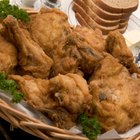
How to Par-Cook Chicken Before Frying
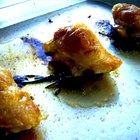
How to Cook Chicken Thighs
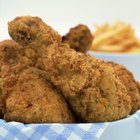
How Much Oil in a Pan to Fry Chicken ...
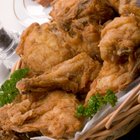
How to Fry Bone in Chicken

How to Marinate Roast Chicken

How to Cook a Thin Breaded Chicken ...

Should Chicken Wings Be Boiled Before ...

How to Get a Crispy Crust on Roasted ...

How to Broil Chicken on the Bone
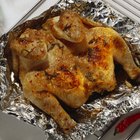
How to Cook a Chicken in a Toaster Oven ...

How to Make Crock-pot Chicken
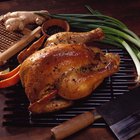
How to Roast a Whole Chicken with a ...
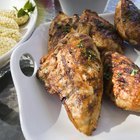
Can I Cook a Chicken Five Days After ...

Does Chicken Have to Be Completely ...
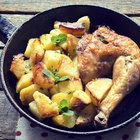
How to Sear and Bake Chicken
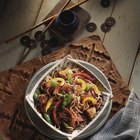
How to Cook Chicken Chunks in a Skillet
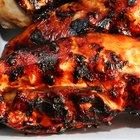
How to Cook Half a Breast of Chicken

How to Re-Crisp a Cold Roast Chicken
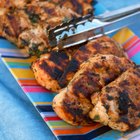
How to Pre-Bake Skinless Chicken Thighs ...

The Best Ways to Make a Baked Moist and ...
References
- The Kitchn: How to Cook Boneless Skinless Chicken Thighs in the Oven
- Recipe Tips: Grilling and Broiling Chicken
- Bon Appetit: Skillet-Fried Chicken
- FoodSafety.gov: Safe Minimum Cooking Temperatures
- U.S.D.A. Food Safety and Inspection Service: Washing Food: Does it Promote Food Safety?
- The Splendid Table: Real Southern Deep-Fried Chicken
Writer Bio
Rachel Lovejoy has been writing professionally since 1990 and currently writes a weekly column entitled "From the Urban Wilderness" for the Journal Tribune in Biddeford, Maine, as well as short novellas for Amazon Kindle. Lovejoy graduated from the University of Southern Maine in 1996 with a Bachelor of Arts in English.
Photo Credits
Jupiterimages/liquidlibrary/Getty Images